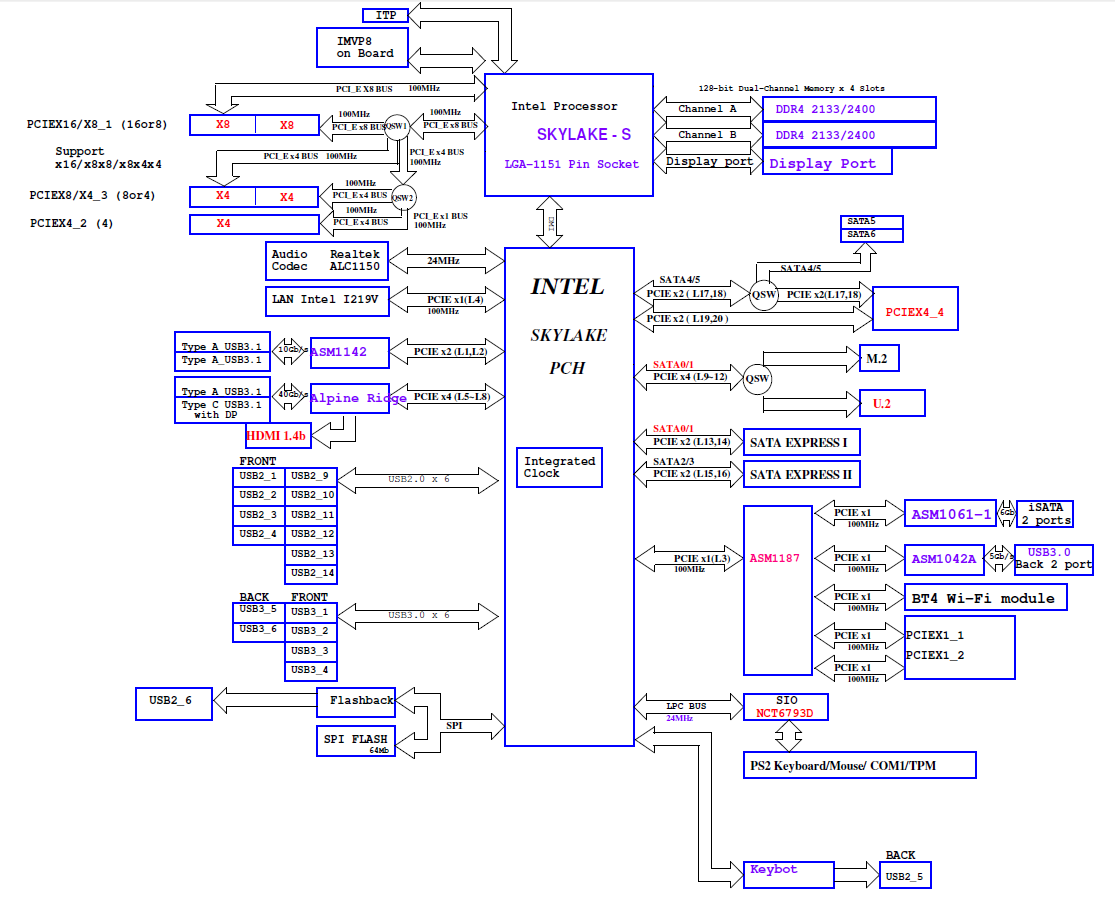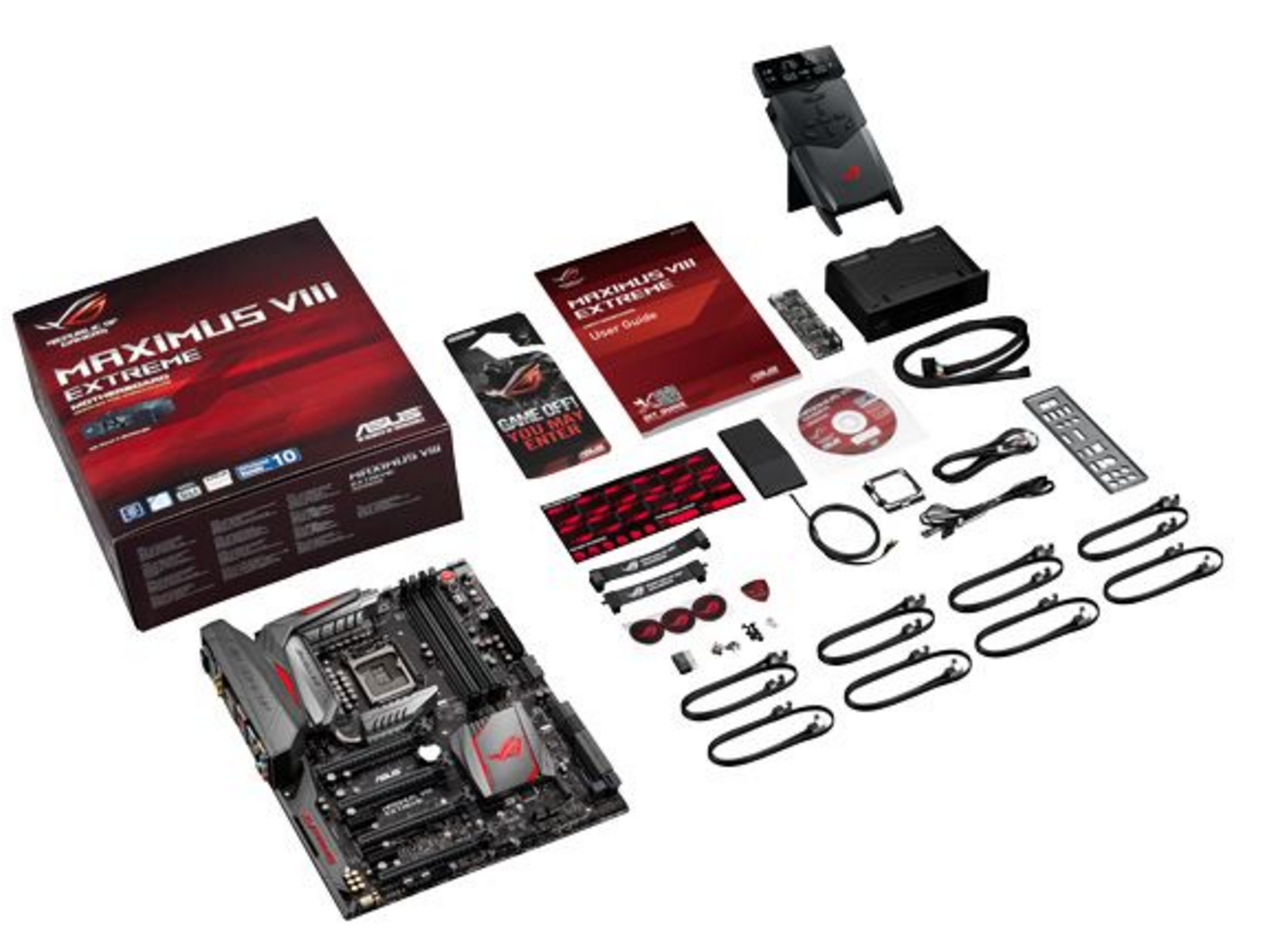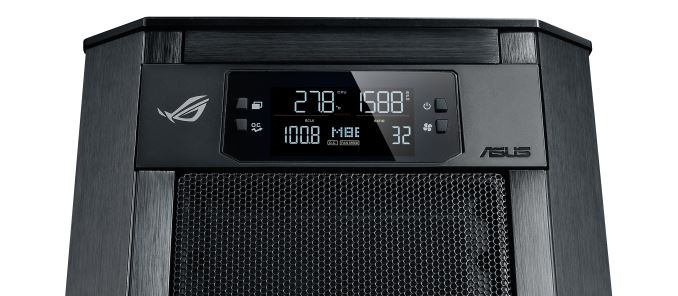The ASUS Maximus VIII Extreme Review: The Other $500 Option
by Ian Cutress on April 7, 2016 9:00 AM EST- Posted in
- Motherboards
- Gaming
- Asus
- ROG
- Skylake
- Z170
- Thunderbolt 3
Board Features
Having gone through and generated the following table for the M8E, I find it mildly amusing, especially as I’ve just put a $120 motherboard on the test bed here. By comparison, instead of most of the sections saying none/blank, when dealing with a $500 motherboard everything is filled up. More SATA ports, more features and more room to add things means that a halo motherboard has to be the Rambo of a PC build.
| ASUS Maximus VIII Extreme | |
| Warranty Period | 3 Years |
| Product Page | Link |
| Price | Amazon US |
| Size | E-ATX |
| CPU Interface | LGA1151 |
| Chipset | Intel Z170 |
| Memory Slots (DDR4) | Four DDR4 Supporting 64GB Dual Channel Up to 3866 MHz |
| Memory Slots (DDR3L) | None |
| Video Outputs | HDMI to 4096x2160 @ 24 Hz DisplayPort at 4096x2304 @ 60 Hz |
| Network Connectivity | Intel I219-V 3T3R 802.11ac Wi-Fi Go! Module |
| Onboard Audio | Realtek ALC1150 with ESS ES9023P DAC bypass |
| PCIe Slots for Graphics (from CPU) | 3 x PCIe 3.0 (x16, x8/x8, x8/x4/x4) |
| PCIe Slots for Other (from PCH) | 1 x PCIe 3.0 x4 2 x PCIe 3.0 x1 |
| Onboard SATA | Six, RAID 0/1/5/10 Two from ASMedia ASM1061 |
| Onboard SATA Express | Two, RAID |
| Onboard M.2 | 1 x PCIe 3.0 x4 or SATA, RAID 0/1, NVMe |
| Onboard U.2 | 1 x PCIe 3.0 x4 (switched with M.2) |
| Thunderbolt | TB3 via Type-C |
| USB 3.1 | 2 x Type-A from ASMedia ASM1142 Controller 1 x Type-A and 1 x Type-C from Intel Alpine Ridge |
| USB 3.0 | 4 x Rear Panel 4 via headers |
| USB 2.0 | 6 via headers |
| Power Connectors | 1 x 24-pin ATX 1 x 8-pin CPU 1 x 4-pin CPU |
| Fan Headers | 1 x CPU (4-pin) 1 x CPU_OPT (4-pin) 4 x CHA/SYS (4-pin) |
| IO Panel | 1 x Combination PS/2 4 x USB 3.0 3 x USB 3.1 Type-A 1 x USB 3.1 Type-C 1 x Network RJ-45 (Intel I219-V) HDMI DisplayPort Clear CMOS Button USB BIOS Flashback Button 3T3R 802.11ac Wi-Fi Go! Module Audio Jacks |
| Other Features | OC Panel Header Thunderbolt Header 4-pin EZ-PLUG Header Front Panel Header 5-pin Fan Extension Header MemOK! Button Slow Mode Switch 9 x Voltage measurement points 3 x Thermal Sensor Headers 1 x DRAM Channel Jumper Power/Reset Buttons BIOS Switch Button SLI/CFX Switch LN2 Mode Jumper Safe Boot Button ReTry Button |
The big active features for ASUS come in at the 3T3R tri-stream WiFi, an ESS DAC, Thunderbolt 3 support via Intel’s Alpine Ridge controller, a total of four USB 3.1 ports split between the Alpine Ridge and ASMedia’s ASM1142 controller and then the sheer amount of switches and buttons onboard for power users to configure their experience. The OC Panel header for both power users and extreme overclockers comes in handy with the bundled OC Panel.
Using the chipset diagram, it shows a slightly more complex picture. Everything on the left side is what we would expect, including the complex way that x8/x4/x4 is implemented on the PCIe side, although it is worth noting that the HDMI 1.4b port is provided through the Alpine Ridge controller rather than the CPU. I would assume this is actually just a bypass to help with routing though it may suggest that the TB3 controller cannot use HDMI when the DisplayPort functionality is in use. I’ll be synchronizing with ASUS on this.
On the right hand side we see that two of the SATA ports (4/5) share bandwidth with the PCIe x4 slot at the bottom of the board. When SATA devices are connected, the PCIe slot will reduce to x2 bandwidth. Also on the right hand side is an ASM1187 controller, which looks like a 6-port PCIe switch. Taking one PCIe lane in, it gives an output to five ports which include the two ASMedia SATA ports, two of the rear USB 3.0 ports, the Wi-Fi module and the two PCIe x1 slots. However, unless one of the PCIe x1 slots is using full bandwidth, I doubt it is much of an issue, and if anything it would be a latency issue. But it might also explain why we could not get proper USB 3.0 speed results through the ASMedia controller.
In The Box
We get the following:
User Manual
Driver DVD
Rear IO Shield
OC Panel plus 5.25-inch Bay
Fan Extension Board
Wi-Fi Antenna
Thermal Probes
CPU Installation tool
Eight SATA Cables
Q-Connectors
ASUS ROG Stickers
ASUS ROG Door Handle Sign
Flexi-CrossFire Connector
Flexi-SLI Connector
At $500 and being part of the ROG brand it means the in-box goodies should be plentiful. The star of the pack is the OC Panel, used by extreme overclockers to make adjustments on the fly or system builders to monitor fan speeds/temperatures with one-button overclocks.
We’ve discussed the OC Panel at length before, and this is the third generation with the same model, featuring more fan headers, VGA Hotplug and extra switches for system control.
Also in the box are a set of thermal probes to use on the extra thermal probe headers on the motherboard, giving the ASUS software extra read points for temperature if the user wants to monitor specific zones in their build. The CPU installation tool is there to help new build users put the processor in the motherboard, although I didn’t find much use for it (I’ve never dropped a CPU in a socket yet…). It is interesting to see so many SATA cables in the box though, however these are mostly likely bought in bulk and minimal cost to a board like this.
ASUS also sells the Maximus VIII Extreme/Assembly, which comes with a custom audio output dock as well as a Tahuti Networks based 10 gigabit Ethernet card using RJ-45.













70 Comments
View All Comments
BrokenCrayons - Thursday, April 7, 2016 - link
"Yes, blowing that much money on frivolous casual dining, outings and shopping is obviously a demonstration of financial brilliance!"It most certainly isn't wasted money and is part of my "fun cash" allotment to myself after bills are paid and my savings and retirement funds are given their budgeted amounts. So what you're effectively seeing is the result of financial planning and numerous years strictly sticking to a budget. It's not brilliance, but it is a very regimented commitment to a monetary standard.
sweenish - Thursday, April 7, 2016 - link
What you're failing to understand is that "wasted" money to you is not necessarily wasted money to someone else.You're way of doing things is not universal, and neither is how you decide to spend your money for fun. Get over yourself.
BrokenCrayons - Friday, April 8, 2016 - link
I don't think you actually read the chain of posts above yours fully before replying. It doesn't seem like you've comprehended the nuances of the discussion prior to developing feelings about it.A5 - Thursday, April 7, 2016 - link
I don't think anyone buying a $500 motherboard runs in social circles that have the same priorities as you do.It's obviously an insane product, but I assume it brings in a decent profit at low volumes.
ASEdouardD - Thursday, April 7, 2016 - link
As with most things, the rationality of spending that much on a motherboard really depends on how much money you have to spend. If you make 500k a year and like this stuff, why the hell not.Murloc - Thursday, April 7, 2016 - link
yeah people who buy this stuff, besides a few extreme overclockers, are usually rich kids who get into this stuff and just buy the best.They're paying a premium but that premium isn't too much for them so that's good for asus and everybody else.
haukionkannel - Friday, April 8, 2016 - link
Well, I have old Extreme board and the best part is that it has been a trouble free instrument in my setting. The Mother board is now 8-9 years old and still working perfectly!You pay for quality components. I have done only very minor overclocking and preferred stability and durability over maximum performance.
Azethoth - Saturday, April 9, 2016 - link
I just built my Mom a new computer. The last one lasted 7 years. The new one has a Maximus VIII Hero from Fry's. If Fry's stocked the extreme I would have bought that, but limited time meant not waiting for an Amazon delivery. Assuming the same 7 year life span (old comp still worked, just not compatible with 8TB drives), it is less than $100 a year for the MB. Like the old one it is not overclocked and the extra lifespan from better components means I do not have to worry about it like I used to when she got Dells. Does she need 64GB of memory, nope. 2TB Samsung Pro? Nope. 2 8TB HGST He8 drives for the raid, nope. Netgear M4100-D12G switch with all shielded CAT7 cabling? Nope. Thermaltake Core 71 case? Nope, but she wanted a taller case so it is easier to put stuff on top of it and 71 sounds like better quality than 51.Is it worth maxing as much as possible? Yep. I anticipate that this machine will last 10 years and never break, unless 4k VR home movies suddenly becomes a thing and she gets into it and I have to fill up a few more drive bays or get a stupid expensive NAS. Oh yeah and Ashes of the Singularity is gonna scream.
Gastec - Thursday, September 22, 2016 - link
Get outta here! 500 bucks is pocket change, I pay more to fill up my Reventón every week :)arayoflight - Thursday, April 7, 2016 - link
Is there anything meaningful that it offers over Z170 deluxe, which is I guess the only option of you want fast onboard WiFi.